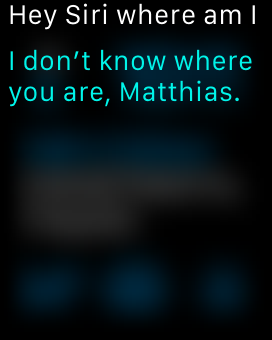The bottom line: as in most of the reviews I've read, I found the Watch intriguing, fun to use, and full of potential, but it just doesn't make a compelling case for itself as a must-have yet. Even so, I was surprised how much I liked it and how tempted I was to buy one. I'll be keeping a close eye on its future development, and in a couple years I could easily see myself plunking down a few hundred dollars for Watch 3.0.
Physical device and user interface
Maybe the most important thing about the Apple Watch is how impressively finished it is. In both hardware and software, it just doesn't feel like a version 1 -- it has no rough edges, literally or figuratively. It's clearly the product of a singularly coherent design vision (Jony Ive, I presume?), executed brilliantly. As a piece of tech, it's quite remarkable.
As a piece of tech, it’s quite remarkable.
The build quality is, even for Apple, astonishing. It feels solid (this is the smaller 38mm size, which seemed the right size for me), and no heavier than it ought to be. It's elegant to look at and pleasing to touch. The screen has dark blacks, vivid colors, and a seamless pixel density that seems higher than the iPhone's, even though it isn't, and it was clearly readable in all but full sunlight. The Digital Crown rotates tightly and smoothly and feels well oiled. Nothing about the device feels cheap, except possibly the band we have it on, and there are plenty of other options there.
The user interface was a pleasant surprise. In particular, the Force Touch gesture is marvelous. You just have to press down a little bit to trigger it -- not so much that it's annoying, but enough that you'll never trigger it accidentally. The Watch also acknowledges the Force Touch by vibrating slightly, which creates the odd, and oddly pleasing, sensation that you're pushing slightly into the screen. The idea that this gesture unlocks a second tier of functions became familiar very quickly, and I soon found myself instinctively looking for features there and usually finding them.
I had more trouble getting used to the Digital Crown wheel, which is mostly used for scrolling and zooming. I opened up some photos I'd synced from my phone, and I got stuck after zooming in by touch -- I couldn't figure out how to zoom back out. It took me quite a while to remember the wheel was there. After the second time that happened, I got it, and everything was fine from then on.
The haptic (touch-sensory) feedback mechanism -- excuse me, I mean the "Taptic Engine" (ugh) -- is rather nice; it feels much like a discreet tap on the shoulder. It very quickly became routine to feel a short buzz on my wrist, glance down briefly to take in the subject line of a new email, and go back to whatever I was doing. (No hands!) They've deployed the feature in a number of interesting ways, of which the nicest is probably the use of different tap patterns and sound cues to signal right and left turns when you're using turn-by-turn directions.
The only problem I had with the haptics was that it was easy to miss the tap if I wasn't standing still. Heading home from the subway, I turned on walking directions, and I never felt the taps. Driving worked much better.
Apple has clearly doubled down on its fascination with animation-driven interfaces. While the iPhone pioneered the pervasive use of animation, it feels like it's really baked into the Apple Watch at a deeper level. It permeates the interface, often in very clever ways, so much that you largely stop noticing it. The better third-party app developers have already picked up on that and incorporated it into their own designs.
What I didn't like
As remarkable as it is, the Apple Watch is inherently limited by its small size and relatively low computing power. It was occasionally irritating when I wanted to do things that I couldn't, like respond to an email or file a to-do item. The frustration seemed strangely familiar, and I pretty quickly figured out why: the Watch is frustrating compared to the iPhone in exactly the same way the iPhone is frustrating compared to a Mac. The constraints get in your way a little. Instagram on your watch is lovely, except you can barely see the pictures.
It's easier if you think of the Watch as a tiny avatar of your phone -- which is really what it is, anyway, at this point. It gives you a slightly more convenient way to do very small things without fetching your phone. That's not a bad thing, but it's limiting. Was it fun to call up “Harbor” by Vienna Teng on the music player without digging my phone out of my pocket? You bet it was. But this wasn't a problem that desperately needed solving, and that goes for most of its other capabilities, too. But moderately improved convenience isn't, in itself, transformational.
It’s easier if you think of the Watch as a tiny avatar of your phone
(While I was drafting this article, Marco Arment, the original creator of Instapaper, published a characteristically thoughtful post describing the evolution of the Watch interface for his podcast app, Overcast. He agrees: "For most types of apps, the Apple Watch today is best thought of not as a platform to port your app to, but [as] a simple remote control or viewport into your iPhone app.")
It's also a little dispiriting that the Apple Watch is basically dead weight in the absence of a paired phone. I'm hoping that future development will change that somewhat.
I found turn-by-turn directions a bit hard to use, although it wasn’t clear how much of the blame belongs to the Watch. The device struggled to get a fix on my location as I walked home from the subway, but it doesn’t have its own GPS; it piggybacks on the iPhone's service, which was clearly having some trouble. Likewise, problems with the Apple’s infamous map data don’t reflect on the Watch, even though it does affect the experience. (More than once, the directions got stuck instructing me to go to the start of the route, when I was already there. I didn’t discover till later that you can swipe up and down to step through the sequence of turns.)
The experience did at least provide one moment of comical existential despair:

Finally, in a rare stumble, I couldn't get the Handoff feature to work, where you begin an action on the Apple Watch and then pick up the iPhone app in the same context. My phone stubbornly refused to recognize any activity on the Watch. A quick visit to Google revealed that this isn't unusual. One poster on a discussion forum wrote, "Spoke to Apple watch support via chat and they said their watches didn't do it either."
Oh, and also, my left arm kept getting tired from holding my wrist up.
Activity tracking
The Apple Watch's fitness features are among its biggest selling points. Unfortunately I'm a couch potato and I never even activated them.
Third party apps
When you pair the Watch to your iPhone at setup time, the system scours your phone for apps that have an Apple Watch component and automatically installs the ones it finds on the Watch. I was startled to see two or three dozen apps appear. I tried them all, and it was a mixed bag. The vast majority of them have no apparent reason to exist, other than the developers' determination to have an Apple Watch app. Most of those I quickly deleted. The better ones seem to understand that convenience is central to the Watch experience, and have developed with that in mind.
A few standouts:
1Password is an indispensable password manager for OS X and iPhone, and the Watch version is very well thought out: rather than uselessly trying to duplicate the main app's functions, it focuses on keeping a few of your secure items, which you select, on the Watch for quick access. In my case, it proved a very convenient way to store a reminder of a door code that I'm constantly forgetting -- much faster than my usual process of fumbling for my phone, scrolling around to find 1Password, entering my password, and searching for the secure note where the code is stored. The Watch app is protected by a PIN.
Things: I'm a heavy user of this to-do management app from Cultured Code, on both OS X and iOS, and the Watch version of this app was ready on day one. It's a good effort; they're clearly thinking hard about the right way to push an app through the tiny screen, and they've obviously recognized the level of visual flair that the Watch seems to require. But it's not quite there. While it does provide a minimal feature set very well indeed, the feature set was a little bit too limited to be truly useful; there's a slight mismatch between the things I needed at my fingertips and the tools it actually provides. Worse, the designers inexplicably devoted some of the precious screen real estate to an attractive but pointless little graph of (I think) how many items you've checked off on the last few days.
Instapaper: This was perhaps the cleverest transition to the Apple Watch of any app I've seen. Instapaper saves the text of web articles for offline reading. There's no way to make that work on the Watch's tiny screen, but the developers did something ingenious: they took the voice synthesis feature that the iPhone app gained a while back and put it on the Watch. You can't read your articles on the Apple Watch, but it can read them to you.
Built-in apps
The built-in apps are mostly excellent. The speech recognition has gotten incredibly good, good enough for text messaging even without the ability to edit your texts before sending them (although you have the option of sending them as audio if the speech recognition isn't working for you). The watch faces are nicely customizable; I started with an analog face but ended up using the basic "Modular" digital face, which used the space better and felt more natural to this device.
Apple gave the Watch a couple of showy gimmicks that aren't very useful but are a lot of fun. You can have it record your heartbeat and reproduce it on another user's wrist. I'm sure that's very lovely and intimate when it's your significant other, but, as I found out, when it's a guy you used to work with in California it's a little creepy. The ability to sketch images with your finger and have the sketching play back on a friend's Watch, before blowing away in a particularly gorgeous bit of animation, is fun for a bit and makes a nice demo, but that's about it.
Not quite a gimmick is the Watch extension to the iPhone camera app. It's going to revolutionize the selfie: you can set the phone up, get into frame, check the image on the Watch (that's the killer feature), and snap the shutter remotely, or, even better, set a three-second timer so you won't be fiddling with your watch in all your photos. If we're lucky, as my girlfriend observed, this could mean the early demise of the selfie stick.
 See?
See?
Almost at the last minute, I discovered that the Watch had also picked up my Dunkin' Donuts card info from the app on my phone and made it accessible via Passbook. On my last morning with the Watch I used it to pay for my coffee, and apart from slight embarrassment (I felt compelled to explain that it wasn't my watch), it worked perfectly. I've been told that Apple Pay is the pièce de résistance, but as I'm still on an iPhone 5, I don't have an account and was unable to test it.
Wrapup
As you can tell by the length of this post, I found the Apple Watch fascinating and quite thought-provoking. I enjoyed it more than I expected, and even got a little attached. It may be, as yet, largely a solution in search of a problem, but as a product, in my opinion, Apple has hit this one out of the park. I'm about to begin developing for it, and after these three days, I'm really excited to get started.

